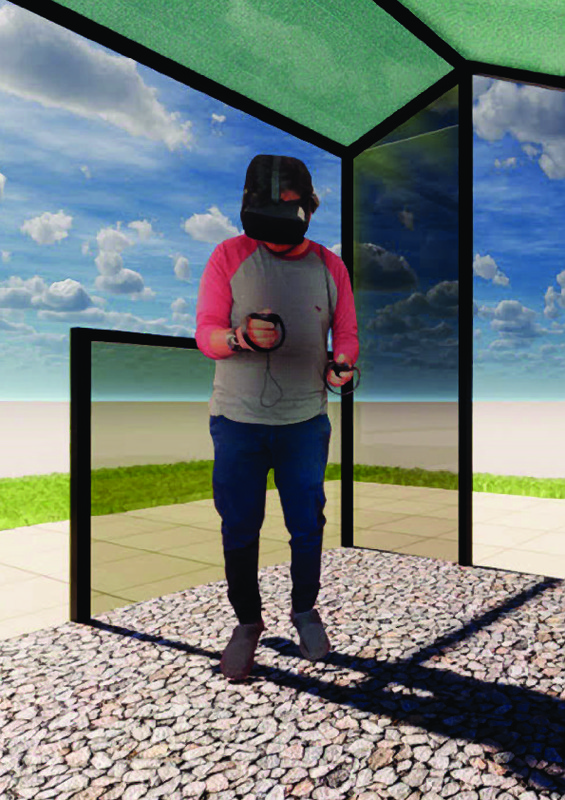Alatta, R. A., & Freewan, A. 2017. Investigating the Effect of Employing Immersive Virtual Environment on Enhancing Spatial Perception within Design Process. ArchNet-IJAR: International Journal of Architectural Research, 11(2), 219. https://doi.org/10.26687/archnetijar.v11i2.1258
Almagro Holgado, M. 2020. Límites de la noción de'affordance''y de la concepción de lo mental en el marco de la psicología ecológica. Teorema: Revista Internacional de Filosofía, 39(1), 135-149.
Angulo, A. 2013. On the design of architectural spatial experiences using immersive simulation. EAEA 11 Conference Proceedings, Envisioning Architecture: Design, Evaluation, Communication. Italy: Milan, 151-158.
[+]
Alatta, R. A., & Freewan, A. 2017. Investigating the Effect of Employing Immersive Virtual Environment on Enhancing Spatial Perception within Design Process. ArchNet-IJAR: International Journal of Architectural Research, 11(2), 219. https://doi.org/10.26687/archnetijar.v11i2.1258
Almagro Holgado, M. 2020. Límites de la noción de'affordance''y de la concepción de lo mental en el marco de la psicología ecológica. Teorema: Revista Internacional de Filosofía, 39(1), 135-149.
Angulo, A. 2013. On the design of architectural spatial experiences using immersive simulation. EAEA 11 Conference Proceedings, Envisioning Architecture: Design, Evaluation, Communication. Italy: Milan, 151-158.
Arnheim, R. 1986. A plea for visual thinking. In New essays on the psychology of art (pp. 135-152). University of California Press. https://doi.org/10.1525/9780520907843-013
Brandão, G. V. L., do Amaral, W. D. H., de Almeida, C. A. R., & Castañon, J. A. B. 2018. Virtual reality as a tool for teaching architecture. International Conference of Design, User Experience, and Usability, 73-82. https://doi.org/10.1007/978-3-319-91803-7_6
Dezcallar Sáez, T. 2012. Relación entre procesos mentales y sentido háptico emociones y recuerdos mediante el análisis empírico de texturas. Universitat Autònoma de Barcelona,.
Ergan, S., Radwan, A., Zou, Z., Tseng, H., & Han, X. 2019. Quantifying human experience in architectural spaces with integrated virtual reality and body sensor networks. Journal of Computing in Civil Engineering, 33(2), 04018062. https://doi.org/10.1061/(ASCE) CP.1943-5487.0000812
Fieandt, K., Järvinen, E., & Korkala, P. 2007. Space perception. Encyclopaedia Britannica.
Ghani, I., Rafi, A., & Woods, P. 2020. The effect of immersion towards place presence in virtual heritage environments. Personal and Ubiquitous Computing, 24(6), 861-872. https://doi.org/10.1007/s00779-019-01352-8
Gomes, R., Aquilué, I., & Roca, E. 2017. Cuerpo, espacio y el dibujo arquitectónico. ACE: Architecture, City and Environment. https://doi.org/10.5821/ace.12.34.5289
Gómez-Tone, H. C., Bustamante Escapa, J., Bustamante Escapa, P., & Martin-Gutierrez, J. 2021. The Drawing and Perception of Architectural Spaces through Immersive Virtual Reality. Sustainability, 13(11), 6223. https://doi.org/10.3390/su13116223
Hermund, A., Bundgaard, T. S., & Klint, L. S. 2017. Speculations on the representation of architecture in virtual reality: How can we (continue to) simulate the unseen? 10.
Holth, J., & Schnabel, M. A. 2017. Immersive virtual environments as a tool for exploring perceptional space. International Journal of Parallel, Emergent and Distributed Systems, 32(sup1), S155-S162. https://doi.org/10.1080/17445760.2017.1390090
Homolja, M., Maghool, S. A. H., & Schnabel, M. A. 2020. The Impact of Moving through the Built Environment on Emotional and Neurophysiological State-A Systematic Literature Review.
Keenan, M. 2020. Perception. In Salem Press Encyclopedia of Health. Salem Press. http://search.ebscohost.com/login.aspx?direct=true&db=ers&AN=109057209&lang=es&site=eds-live&scope=site
Kuliga, S. F., Thrash, T., Dalton, R. C., & Hölscher, C. 2015. Virtual reality as an empirical research tool-Exploring user experience in a real building and a corresponding virtual model. Computers, Environment and Urban Systems, 54, 363-375. https://doi.org/10.1016/j.compenvurbsys.2015.09.006
Li, J., Jin, Y., Lu, S., Wu, W., & Wang, P. 2020. Building environment information and human perceptual feedback collected through a combined virtual reality (VR) and electroencephalogram (EEG) method. Energy & Buildings, 224, N.PAG-N.PAG. https://doi.org/10.1016/j.enbuild.2020.110259
Lizondo Sevilla, L., Santatecla Fayos, J., Martínez García, S. J., & Bosch Reig, I. 2014. La influencia de la arquitectura efímera en la arquitectura construida. El caso de Mies van der Rohe. ACE: Architecture, City and Environment, 8(24), 73-94. https://doi.org/10.5821/ace.8.24.2717
Maghool, S. A. H., Homolja, M., & Schnabel, M. A. 2020. Cybernetics Approach to Virtual Emotional Spaces-An electrodermal activity actuated adaptive space. https://doi.org/10.26686/wgtn.13019327
Mitrache, A. 2013. Spatial Sensibility in Architectural Education. Procedia - Social and Behavioral Sciences, 93, 544-548. https://doi.org/10.1016/j.sbspro.2013.09.236
Moloney, J., Globa, A., Wang, R., & Khoo, C. 2019. Principles for the application of mixed reality as pre-occupancy evaluation tools (P-OET) at the early design stages. Architectural Science Review, 1-10.
Nisha, B. 2019. The pedagogic value of learning design with virtual reality. Educational Psychology, 39(10), 1233-1254.
Norberg-Schulz, C. 1980. Existencia,espacio y arquitectura. Barcelona: Blume.
Pallasma, J. 2006. Los ojos de la piel. Barcelona: Gustavo Gili.
Rasmussen, S. E. 2004. La experiencia de la arquitectura (Vol. 5). Reverté.
Roberts, G., Holmes, N., Alexander, N., Boto, E., Leggett, J., Hill, R. M., Shah, V., Rea, M., Vaughan, R., Maguire, E. A., Kessler, K., Beebe, S., Fromhold, M., Barnes, G. R., Bowtell, R., & Brookes, M. J. 2019. Towards OPM-MEG in a virtual reality environment. NeuroImage, 199, 408-417. https://doi.org/10.1016/j.neuroimage.2019.06.010
Saldarriaga Roa, A. 2002. La arquitectura como experiencia: Espacio, cuerpo y sensibilidad. Univ. Nacional de Colombia.
Sánchez, O., & Hessman, D. 2018. El aprendizaje de la percepción del espacio arquitectónico: Una aproximación a su comprensión desde la experiencia en el taller de diseño uno [Universidad Nacional de Colombia]. https://repositorio.unal.edu.co/handle/unal/64112
Sánchez Vidiella, A. 2016. Arquitectura efímera: 100 proyectos, 1000 ideas (1ra ed.). Promopress.
Shemesh, A., Talmon, R., Karp, O., Amir, I., Bar, M., & Grobman, Y. J. 2017. Affective response to architecture-investigating human reaction to spaces with different geometry. Architectural Science Review, 60(2), 116-125.
Yeom, D., Choi, J.-H., & Kang, S.-H. 2019. Investigation of the physiological differences in the immersive virtual reality environment and real indoor environment: Focused on skin temperature and thermal sensation. Building and Environment, 154, 44-54.
[-]








